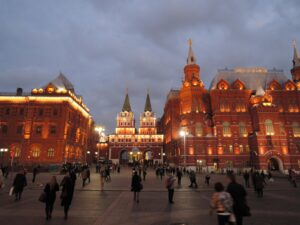
Russia, with its vast natural resources and strategic geopolitical position, has a complex and evolving tax system that plays a crucial role in its economic stability and growth. Understanding the intricacies of Russia’s tax framework is essential for comprehending how the government funds its operations, supports social programs, and influences economic behavior. This essay will explore the various aspects of the Russian tax system, its impact on individuals and businesses, and the ongoing reforms aimed at enhancing its efficiency and fairness.
Read also: The Fiscal Framework of China
Historical Context and Evolution
The evolution of Russia’s tax system is closely linked to its political and economic transformations. During the Soviet era, the economy was centrally planned, and taxation played a limited role. The state controlled most economic activities, and revenue was primarily generated through state-owned enterprises. However, the collapse of the Soviet Union in 1991 necessitated a complete overhaul of the fiscal framework to support a market-oriented economy.
In the 1990s, Russia implemented significant tax reforms to stabilize its economy and attract foreign investment. The introduction of the Tax Code in 1998 marked a pivotal shift, providing a comprehensive legal framework for taxation. This reform aimed to simplify the tax system, broaden the tax base, and improve compliance. Over the years, further adjustments have been made to align Russia’s tax policies with international standards and address domestic economic challenges.
Structure of the Russian Tax System
Russia’s tax system is composed of various direct and indirect taxes, each designed to fulfill specific fiscal objectives and support public services.
Personal Income Tax (PIT): The Russian personal income tax is relatively straightforward, with a flat rate of 13% for most individuals. This rate applies to residents on their worldwide income and non-residents on their Russian-sourced income. High earners, defined as those earning over 5 million RUB annually, are subject to an additional 2% surtax introduced in 2021.
Corporate Income Tax (CIT): The standard corporate income tax rate is 20%, with 3% allocated to the federal budget and 17% to regional budgets. Certain sectors, such as small businesses and innovative enterprises, may benefit from reduced rates or tax holidays. The CIT framework encourages regional development by allowing local governments to offer incentives to attract investment.
Value-Added Tax (VAT): VAT is a significant revenue source for the Russian government, applied to most goods and services at a standard rate of 20%. Reduced rates of 10% apply to essential items such as food, children’s goods, and medical supplies. VAT is collected at each stage of production and distribution, ultimately borne by the end consumer.
Social Security Contributions: Employers are required to contribute to social security funds covering pensions, healthcare, and social insurance. The rates vary depending on the type of contribution but generally amount to around 30% of an employee’s salary. These contributions fund Russia’s extensive social welfare programs, providing a safety net for workers and retirees.
Excise Taxes: Excise taxes are levied on specific goods such as alcohol, tobacco, and petroleum products. These taxes serve both to generate revenue and to influence consumer behavior by discouraging the consumption of harmful products.
Property Taxes: Russia imposes property taxes on both individuals and businesses. The tax is based on the cadastral value of real estate, which is intended to reflect market value more accurately. Property taxes are a crucial source of revenue for local governments, funding regional development and public services.

Impact on Individuals and Businesses
The Russian tax system has significant implications for individuals and businesses, influencing economic decisions and financial planning.
For Individuals: The flat personal income tax rate simplifies tax compliance and is relatively low compared to other countries, making it attractive for residents and expatriates alike. However, social security contributions can be burdensome, particularly for self-employed individuals. Tax deductions and credits, such as those for education, medical expenses, and mortgage interest, help mitigate the overall tax burden.
For Businesses: The corporate tax rate and VAT significantly impact business operations and profitability. While the 20% CIT is competitive, compliance with VAT and social security contributions can be complex and administratively demanding. The availability of regional tax incentives and reduced rates for specific sectors encourages investment and economic diversification.
Regional Disparities and Special Economic Zones
Russia’s vast geographic and economic diversity necessitates tailored fiscal policies to address regional disparities and promote balanced development. Special economic zones (SEZs) and other regional incentives play a crucial role in this strategy.
Special Economic Zones (SEZs): SEZs offer tax holidays, reduced CIT rates, and other incentives to attract foreign direct investment (FDI) and stimulate economic activity in specific regions. These zones have been instrumental in fostering industrial growth and innovation, particularly in regions that lag behind in economic development.
Technology and Innovation Zones: To promote technological advancement and innovation, Russia has established zones dedicated to high-tech industries. These zones provide favorable tax conditions, infrastructure support, and funding for research and development activities. Examples include Skolkovo Innovation Center and the Innopolis in Tatarstan.
Challenges and Reforms
Despite the strengths of its tax system, Russia faces several challenges that necessitate ongoing reforms.
Tax Evasion and Avoidance: Ensuring compliance and combating tax evasion and avoidance remain critical issues. Strengthening enforcement mechanisms, enhancing transparency, and leveraging technology are essential steps in maintaining the integrity of the tax system.
Balancing Tax Burden: While tax incentives and reductions aim to stimulate economic activity, the government must balance these with the need for sufficient revenue to fund public services and infrastructure. Addressing this balance is crucial for sustainable development.
Simplifying Compliance: Reducing the administrative burden of tax compliance, particularly for SMEs, is a priority. Simplifying tax filing procedures, reducing paperwork, and providing clearer guidelines can enhance compliance and reduce costs for businesses.
Environmental Taxes: As part of its commitment to environmental sustainability, Russia is exploring the implementation of environmental taxes, such as carbon pricing. These taxes aim to reduce pollution and encourage sustainable practices, but they must be designed carefully to avoid adverse economic impacts.

Future Directions
Russia’s tax system is likely to continue evolving in response to domestic and global economic trends. Key areas for future development include:
Digital Economy: As the digital economy grows, Russia will need to develop new tax policies to capture revenue from online transactions and digital services. This includes addressing challenges related to cross-border e-commerce and the taxation of digital platforms.
International Cooperation: Russia’s integration into the global economy requires cooperation on international tax issues, such as transfer pricing and tax treaties. Participating in global initiatives, such as the OECD’s Base Erosion and Profit Shifting (BEPS) project, will help Russia align its tax policies with international standards.
Green Taxation: Expanding environmental taxes and incentives for green technologies will be crucial for achieving Russia’s sustainability goals. This includes further developing carbon pricing mechanisms and promoting investments in renewable energy and energy efficiency.
Conclusion
Russia’s tax system is a critical component of its economic strategy, supporting public services, promoting social equity, and fostering economic growth. Understanding the complexities and impacts of this system is essential for navigating the Russian business environment and appreciating the country’s broader economic policies.
As Russia continues to develop and integrate into the global economy, ongoing reforms and adaptations will be necessary to ensure that its tax system remains fair, efficient, and sustainable. By balancing the needs of revenue generation with the goals of social equity and environmental sustainability, Russia can continue to build a prosperous and inclusive society for all its citizens. Through thoughtful policy-making and international cooperation, Russia’s tax system can evolve to meet the demands of the future while maintaining its foundational principles.






